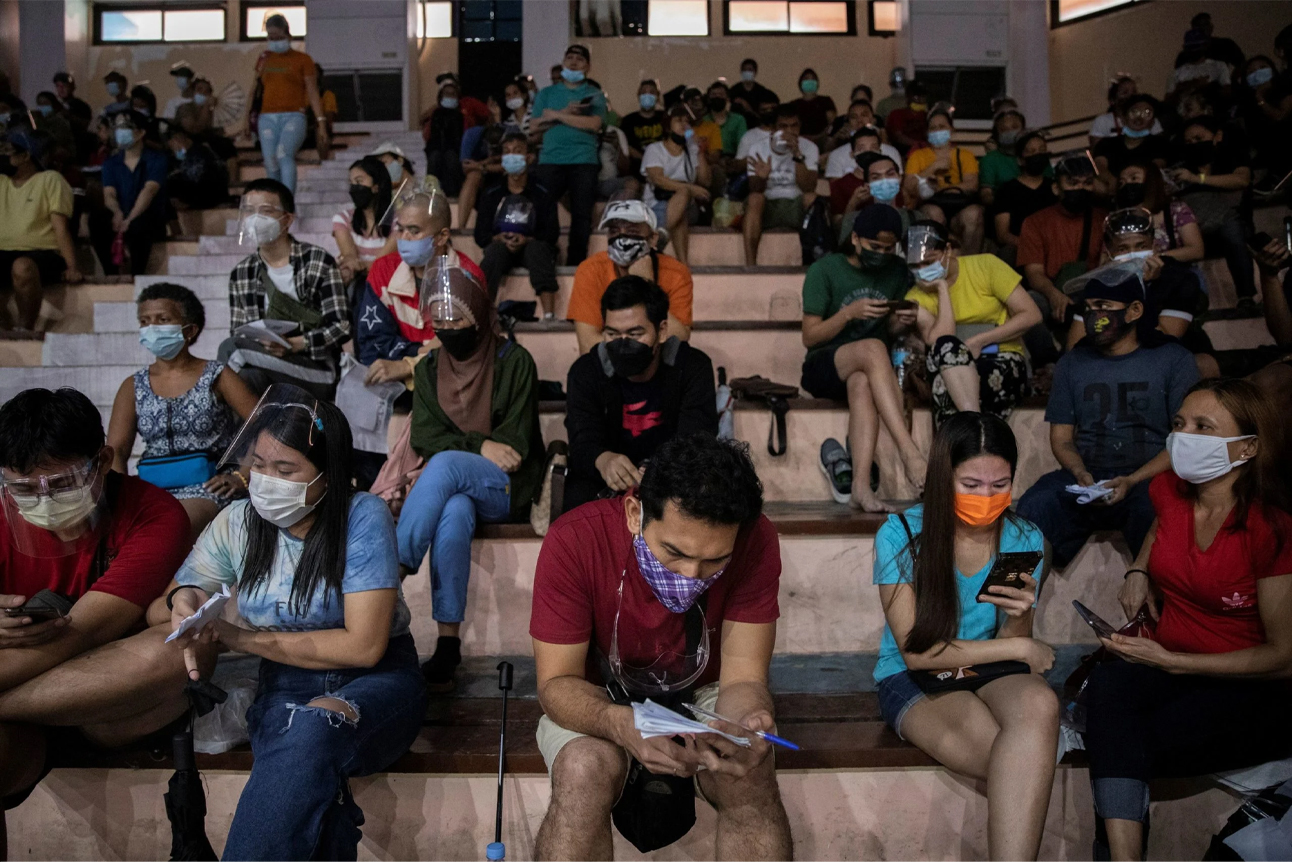Health groups: gov’t COVID response ‘still not enough’

People waiting for their turn at a vaccination site in Manila use their phones to while away time. REUTERS
With health-care workers protesting the delayed release of their benefits amid “unspent or misspent” billion-peso funds, health professionals have coalesced into a unified front, calling out the government for its insufficient response to the COVID-19 pandemic after more than a year.
Dr. Antonio Dans, convener of Health Professionals Alliance Against COVID-19 (HPAAC), said he and his colleagues were not trying “to pick a fight” but had to speak out after the Philippine College of Emergency Medicine (PCEM) and 60 other alliances sounded the alarm.
The government should show “moral support” by ensuring that hospital workers are fairly compensated, said Dr. Benito Atienza, president of the Philippine Medical Association.
Dr. Aileen Espina, in reading the HPAAC message to the government, said: “What we are doing now is still not enough. The data that you are getting are not aligned with what is happening in the communities and hospitals.”
Espina said health professionals had kept open communication lines with the government, “but [after] more than one year, where are the solutions we have long been pushing?”
Article continues after this advertisementFor one, Espina said, she and her colleagues had yet to see “digitized, connected and interoperable” contact tracing.
Article continues after this advertisementShe said the poor coordination between the One Hospital Command Center of the Department of Health (DOH) and the local governments had resulted in patients hospital-hopping and ending up dying at home or in a hospital parking lot.
“We have a huge amount of unspent or misspent money. That is why we do not understand why, until now, the hospitals are unpaid and health-care workers have yet to receive the benefits promised them,” Espina said.
She also said the overall response lacked the “political will” to strictly implement guidelines, especially in workplaces and mass transportation.
Dr. Jeremy Cordero, the PCEM vice president, said emergency rooms, as hospital “gatekeepers,” were feeling the strain with crowds of patients needing care.
“There were times we had to turn away dying patients because we had run out of beds and mechanical ventilators,” Cordero said.
Said HPAAC: “What we’ve been fearing and preventing is already happening—the health-care system can no longer respond to the COVID-19 cases.”
Dr. Maricar Limpin, president of the Philippine College of Physicians, said the group was in support of the health-care workers’ mass protests for just compensation as long as they would not be remiss in fulfilling their duty to their patients.
On the health-care workers’ call for Health Secretary Francisco Duque III to resign, Dans said it was not an issue for him and his colleagues to decide. But he added that Duque’s position in the Cabinet “is a position of trust and confidence.”
Distribution of equipment
In a separate briefing, Health Undersecretary Maria Rosario Vergeire said the DOH agreed with the health professionals that patients queueing at emergency rooms should be included in the national COVID-19 data.
“It’s one of the flags supposedly for the government … to see that the hospitals are getting full,” she said.
Vergeire said that this week, the DOH had begun distributing additional hospital equipment, mechanical ventilators, nasal cannula and oxygen concentrators to hospitals.
She said the DOH was also providing additional tents and strengthening the network between hospitals for patient referrals.
Second highest count
On Friday, the Philippines recorded 20,310 new COVID-19 cases and 193 deaths. A total of 7,710 COVID patients recovered.
The number of new cases was the second highest count since the start of the pandemic in March last year, the DOH said.
It also said that out of 67,759 tests conducted, 27.4 percent tested positive—a rate way up the 5-percent threshold that indicates a sustained transmission.
Vergeire said the number of COVID-19 infections was expected to rise further due to active case finding by the government and the increased testing rate.
The Philippines now has 158,994 active cases, of whom 90.5 percent have recovered and 1.66 percent have died.
Based on the government projection, the DOH said, the number of daily cases in the National Capital Region alone could hit 17,000 to 43,000 by Sept. 30.
But this projection “is not cast in stone” as numbers may change should the local governments impose granular lockdowns, enhance case tracking and ramp up vaccination, the DOH said.
For more news about the novel coronavirus click here.
What you need to know about Coronavirus.
For more information on COVID-19, call the DOH Hotline: (02) 86517800 local 1149/1150.
The Inquirer Foundation supports our healthcare frontliners and is still accepting cash donations to be deposited at Banco de Oro (BDO) current account #007960018860 or donate through PayMaya using this link.